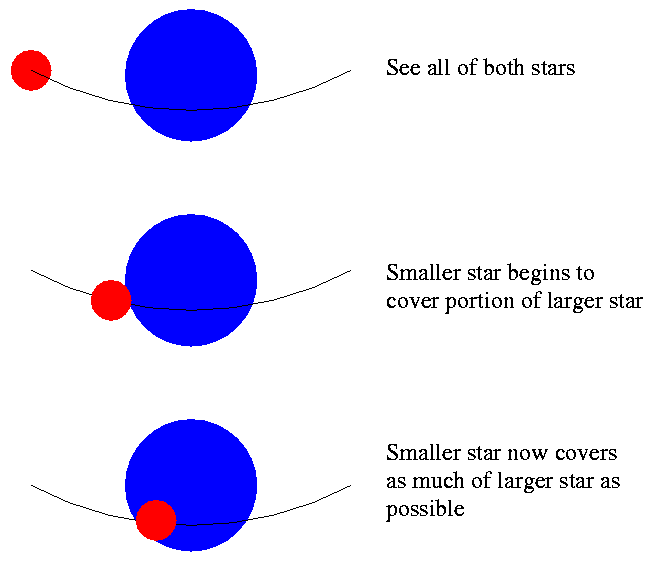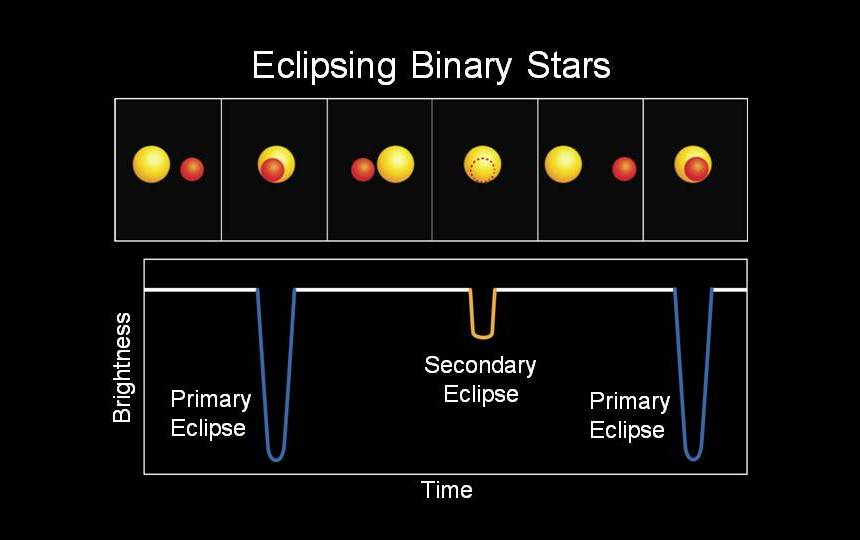Binary star#Eclipsing binaries
An eclipsing variable star, and photometric binary star is a binary star system whose orbit is in the room so that the two stars seen from Earth cover periodically temporarily.
Analysis of the light curve
From the light curve, the change in the brightness of the unresolved binary system during an orbit around the common center of gravity, the following parameters can be derived:
- The orbital period
- The duration of the primary and of the secondary minimum
- The possible duration of the standstill in the minimum in the case of total cover
- The amplitudes of the minima
- The brightness variation in waste and increase in minima
From these data it can be concluded that the surface brightness of the stars, the relative radii, the orbital inclination, limb darkening, gravity darkening, the deviation from the spherical shape by centrifugal forces and the relative distance. If the observation in a photometric system carried out in several wavelengths can also be closed to the surface temperature of the star. Since stars can only accept a limited range of state variables, so that is a determination of the absolute parameters such as luminosity and geometrical parameters, eg Stellar radii, possible.
If the course of the radial velocity determined by the Doppler effect, the masses of the stars and the orbital eccentricity can be calculated. Since only eclipsing stars, the orbital inclination of an optically unresolvable into its component binary system can be determined, they are the main source for the determination of stellar masses.
classification
There are two main classifications for eclipsing binaries based on the light curve and the geometric conditions:
Light curve
- Algolsterne show a nearly constant brightness between the minima
- For beta Lyrae stars of light change varies continuously with rounded maxima, minima but at different depths. The orbital period is between one and up to 20 days.
- The W Ursae Maiori star similar to the Beta Lyrae stars without downtime, the minima are approximately the same depth. The orbital period is shorter than one day.
Geometric conditions
- The separate systems that show no matter exchange between the components
- Semi- separate systems in which one component, the maximum expansion has taken in a double star system. For any further expansion of this component matter would flow to the companion.
- In case of contact systems, each component has returned to the maximum extent, and there is a constant exchange of matter between the two stars
Special shapes
In addition to stars and non-luminous companion can cause coverage. These include exoplanets, brown dwarfs and dust disks as in the case of epsilon Aurigae. Because these objects do not light itself, just a drop in brightness is observed at an eclipsing binaries per round. Planets and brown dwarfs have a much smaller diameter than stars, and therefore the change in brightness minimum is low. In order to achieve the necessary accuracy, the search is performed outside the Earth's atmosphere. For example, the primary goals of the satellite missions Kepler and COROT are the search for exoplanets using the transit method.
There are also triple - cover systems like KOI - 126. Here circulates in an eccentric orbit a star is a close binary star system, two stars of the narrow system can be covered by the extended companion. The light curve appears irregularly variable due to the superposition of the minima.
Benefits for Astrophysics
The astrophysical utility of this class of stars is the possibility by measuring the light curve on the path data and physical state variables of the stars to be able to close in the double star system. So it is with the help of the new generation of large telescopes to find possible eclipsing star within the local group and investigate. Through the derivation of the luminosity of the light curve, the distances to the Magellanic Clouds, the Andromeda Galaxy, the Triangulum Galaxy, and some dwarf galaxies of the Local Group could be determined with an accuracy of up to 6%.
Eclipsing binaries continue to allow the spatial resolution of structures on or near the stars of the binary system. These include:
- The facing hemispheres of the stars are brighter by the reflection effect in close binary systems
- Star spots similar to sunspots
- Flares similar to solar flares
- Matter flows between the stars
- Rings and accretion disks around the ground receiver
- Hot spots on the stellar surface, where matter flows collide and release their kinetic energy
- The Zeta Aurigae and VV Cephei systems, a main sequence star is used as a light source for the screening and analysis of the extended atmosphere of a red giant's
The observation of a Apsidendrehung the path of an eclipsing binary is relatively simple, in this case change as the position of the main and secondary minima relative to each other. Since the Apsidendrehung is also dependent on the structure of the stars in the binary system can be used eclipsing binaries also for verification of models of the internal structure of stars. However, it must be known as in the case of DI Herculis the rotation parameter and the orientation of the axes. The Apsidendrehung can also be used for falsification of alternative theories of gravity. With these hypotheses, the observed deviations of the rotation curves of galaxies, the dynamic stability of clusters of galaxies and gravitational lenses can be equally well explained by galaxies or clusters, such as through the adoption of dark matter. The observed Apsidendrehungen at eclipsing stars with a large orbital eccentricity should be different in a few years from those calculated according to the theory of relativity values and allow a distinction.
Since decreases with distance, the probability of a mutual occultation of the star most eclipsing binaries have short periods and, therefore, a small semi-major axis relative to the stellar radii. Thus, the evolution of stars in binary systems of the individual stars vary due to mass exchange between the components, rapid rotation and magnetic activity.
Period changes
Changes in the total angular momentum of the binary system or in the distribution of angular momentum should lead to a postponement of minimum brightness. Since the change with each rotation smallest deviations are accumulated measurable and Observations show that the orbital periods of many eclipsing variable stars are not constant. The following phenomena are known by one period changes trigger or fake:
- Apsidendrehung
- In the light travel time effect, a third body orbiting the binary star system and thus shifts the focus to the move, the two stars of eclipsing binaries. Due to the finite speed of light shifts this time the minimum brightness.
- Mass exchange between the components
- Mass loss from the binary system, for example, by stellar winds
- Due to the emission of gravitational waves
- The magnetic angular momentum loss occurs when a star loses ionized gas along the magnetic field lines of the star. The gas is frozen in the magnetic field lines to the radius at which the magnetic field rotates with the speed of light. The result is a decrease in the rotational speed of the star, and thus a loss of angular momentum in the binary system
- Applegate the mechanism of rotation in the course of a magnetic pulse cycle redistributed between the inner and outer convection zone of a star. This leads to a change in the Rotationsabplattung and thus indirectly also the orbital period, which thereby both increase and may decrease as well. According to observations Periodenzu cyclical increases and decreases occur almost exclusively on only eclipsing binary stars, which shows at least one component of magnetic activity
- An asymmetric brightness distribution on the hemisphere to be covered by star spots
- Triggered by tidal forces pulsations, which are often in resonance with the orbital period of the binary star.
Most of the observed period changes in eclipsing stars are attributed to the mass exchange between the components of binary star systems. However, the cause of many cyclic period changes is unknown.
Change in the light curve
Runs a third star around the common center of mass and its orbit is not in the plane of the eclipsing binaries, so this leads to a precession of the orbit of the close binary system. As a result, the inclination of the web and thus also the depth of the minimum change. Overall, only a small number of triple systems is known with a varying depth of the minima due to the gravitational influence of a third body. These stars include Algol and HS Hydrae.
In addition, the normal brightness may fluctuate due to changes at the surface of one or both components of the eclipsing binaries. Among the best known examples include the RS Canum - Venaticorum stars. On the surface of late Giants star spots to form with a radius of up to 20 ° and a temperature which is about 1500 K below the undisturbed stellar surface. This leads to depressions in the light curves to years wandering through the light curve over the course of months. For eclipsing binaries due to the bound rotation, the rotation period is identical to the orbital motion of time. The slow migration of star spots on the surface is therefore the result of differential rotation in the late giant. Also eclipsing BY Draconis stars show a similar modulation of the light curve. In this class of stars is late dwarfs with star spots on their surfaces.
If a planet is too close to its host star, it heats to such an extent that parts of its surface evaporate and leave the gravitational field of the Super Mercury matter. When viewed from Earth, the orbit of the planet passes in front of the star, it may be a variable depth and duration of Bedeckungsminima. The circulation period is constant as in the case of KIC 12557548, where the depth of the minima between 0.2% and 1.2% fluctuates. The vaporized material condenses at a distance from the star turn to dust and absorbs the starlight very effective. The Bedeckungslichkurve is asymmetric and, as with all planetary transits missing the secondary minimum.










